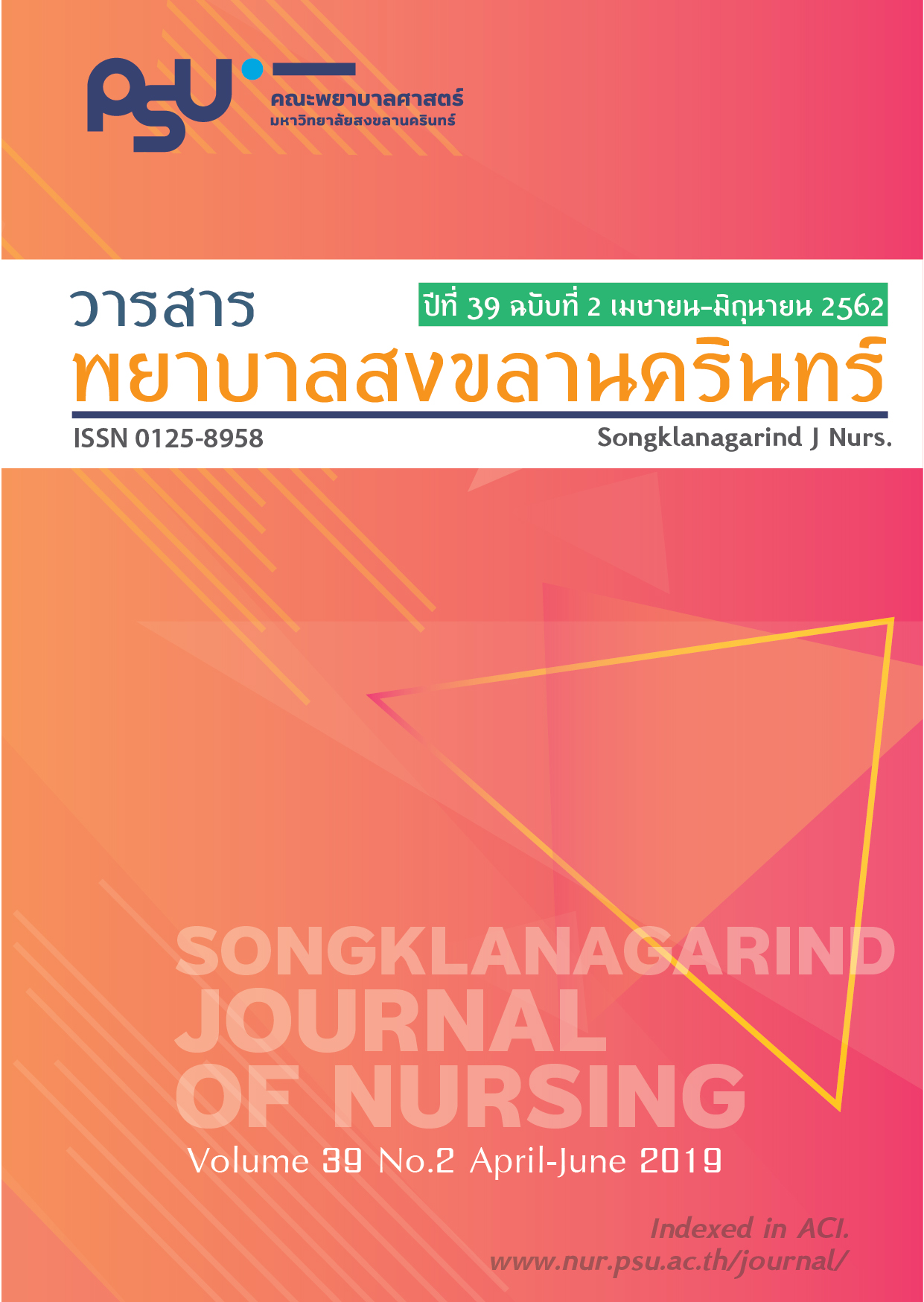Situations and Expectations of TB Care Continuity for Post-Release Persons in Jakarta, Indonesia: A Descriptive Phenomenology
Main Article Content
Abstract
Post-release tuberculosis (TB) treatment completion is crucial for TB prevention and control. However,the situation of post-release continuity of TB care is uncertain. The study aims to describe the situation and expectations of TB care continuity for persons after release from a prison in Indonesia using descriptivephenomenology. The participants consisted of seven TB patients, a nurse, a physician, a treatment observer in the prison, and a representative of an NGO. All participants were purposively recruited. The TB prisoner-patients were chosen based on having TB and the providers were selected based on the criterion of having experience in caring for prisoners with TB who had to continue their treatments after release. In-depth semi-structured interviews were conducted to explore the perspectives of the participants in post-released continuity of TB care situations and their expectations. The interviews were digitally recorded, transcribed verbatim, and analyzed using Colaizzi’s phenomenological method.
Five themes emerged: (1) lack of employing any provider guidelines to enhance post-release TB continuity of care; (2) loss of contact with patients at the point of release; (3) rarely receiving reports backfrom the health centers due to failure in patient follow-up; (4) desire to recover from TB and looking forward to healthty living after release; and (5) expecting providers to supervise the medications in the pre-and post-release period. This study recommends mechanisms to ensure post-release TB treatment continuationto prevent disease progression and transmission into the community.
Article Details
References
World Health Organization. Global tuberculosis report 2015. WHO Press, Geneva; 2015.
Dara M, Acosta CD, Melchers NVSV, et al. Tuberculosis control in prisons: Current situation and research gaps. Int J Infect Dis. 2015; 32:111-7. Available from: doi: 10.1016/j.ijid.2014.12.029.
Dara M, Chorgoliani D, de Colombani P. TB prevention and control care in prisons. In: EnggistS, Møller L, Galea G, Udesen C, editors. Prison and health. Copenhagen: WHO Regional Office for Europe; 2014.
Justin O’Grady J, Hoelscher M, Atun R, et al. Tuberculosis in prisons in sub-Saharan Africa-the need for improved health services, surveillance and control. Tuberculosis. 2011; 91(2): 173-78. doi:10.1016/j.tube.2010.12.002.
Sacchi FPC, Praça RM, Tatara MB, et al. Prisons as reservoir for community transmission of tuberculosis, Brazil. Emerg Infect Dis. 2015; 21 (3):452-55. Available from: doi:10.3201/eid2103.140896.
National Commission on Correctional Health Care. The health status of soon-to-be-released inmates. [Internet]. [Cited 2018 January 26]. Available from: https://www.ncjrs.gov/pdffiles1/nij/grants/189735.pdf
Directorate General of Correction of Ministry of Law and Human Rights of Republic of Indonesia. Panduan Penanggulangan Tuberkulosisdi UPT Pemasyarakatan [Tuberculosis Control Guidelines in Correctional Setting]. Jakarta; 2015.
Fatimah, Upe AA, Nurhasanah H, et al. Gambaranfaktor-faktor kejadian infeksi tuberkulosis latendi Rumah Tahanan Kelas I Bandung. [Description of factors related to latent tuberculosis infection in Jail Class I Bandung]. Available from: http://repository.uhamka.ac.id/374/1/Article-7.pdf[cited 26th January 2018]
Matua GA and Van Der Wal DM. Differentiating between descriptive and interpretive phenomeno-logical research approaches. Nurse Res. 2015;22(6): 22-7. doi:10.7748/nr.22.6.22.e1344.
Kemmis S, McTaggart R, Nixon R. The Action Research Planner: Doing Critical Participatory Action Research. Singapore: Springer; 2014.
Patricia I, Fusch, Lawrence R. Are we there yet? Data saturation in qualitative research. Qual Health Res. 2015; 20(9): 1408-1416.
Shosha G. Employment of Colaizzi’S strategy in descriptive phenomenology: A reflection of a researcher. Eur Sci J. 2012; 8(27): 31-43.
Moller L, Gatherer A, Dara M. Barriers to implementation of effective tuberculosis control
in prisons. Public Health. 2009; 123(6): 419-21. doi:10.1016/j.puhe.2009.04.004.
Dara M, Chadha SS, Melchers NV, et al. Time to act to prevent and control tuberculosis among inmates: A statement of the International Union Against Tuberculosis and Lung Disease. Int J Tuberc Lung Dis. 2013; 17(1): 4-5. doi:10.5588/ijtld.12.0909.
Lincoln T, Miles JR, Scheibel S. Community health and public health collaboration. In: Public health behind bars: from prisons to communities. Greifinger RB, Editor. New York: Springer; 2007.p. 508-55.
Harwick K, Dood H, Neusteter SR. Case management strategies for successful jail reentry. Available from: https://www.urban.org/sites/default/files/publication/25886/412671-Case-Management-Strategies-for-Successful-Jail-Reentry.PDF [Accessed 7th September 2017]
Department of Health Human Services Centers for Disease Control and Prevention. Prevention and control of tuberculosis in correctional and detention facilities: Recommendations from CDC. Morbidity and Mortality Weekly Report. 2006;55: 1-53.
Goedvolk M, Walberg A. Evaluation of pilot project for the continuity of care. Available from: https://www.wodc.nl/binaries/2191-summary_tcm28-72441.pdf [Accessed 7th September 2017]
Fox AD, Maradiaga J, Weiss L, et al. Release from incarceration, relapse to opioid use and the potential for buprenorphine maintenance treatment: A qualitative study of the perceptions of former inmates with opined use disorder.Addiction Science & Clinical Practice. 2015; 10(2): 1-9. doi:10.1186/s13722-014-0023-0.
Mallik-Kane K. Returning home Illinois policy brief: employment and prisoner reentry. Available from: https://www.urban.org/sites/default/files/publication/42876/311214-Returning-Home-Illinois-Policy-Brief-Health-and-Prisoner-Reentry.PDF [Accessed 7th September 2017]
Cepeda JA, Vetrova MV, Lyubinova AI, et al. Community reentry challenges after release from prison among people who inject drugs in St.Petersburg, Russia. Int J Prison Health. 2015; 11(3): 183-92. doi:10.1108/IJPH-03-2015-0007.
Christensen S. Enhancing nurses’ ability to care with in the culture of incarceration. J Transcult Nurs. 2014; 25(3): 223-31. doi:10.1177/1043659613515276.
Weiskopf CS. Nurses’ experience of caring for inmate patients. J Adv Nurs. 2005; 49(4): 336-43.
Binswanger IA, Nowels C, Corsi KF, et al.“From the prison door right to the sidewalk, everything went downhill,” A qualitative study of the health experiences of recently released inmates. Int J Law Psychiatry. 2011; 34(4):249-55. doi:10.1016/j.ijlp.2011.07.002.
Van Dooren K, Claudio F, Kinner SA, et al. Beyond reintegration: A framework for under-standing ex-prisoner health. International Journal of Prison Health. 2011; 7(4): 26-36. doi:10.1108/17449201111256880.


